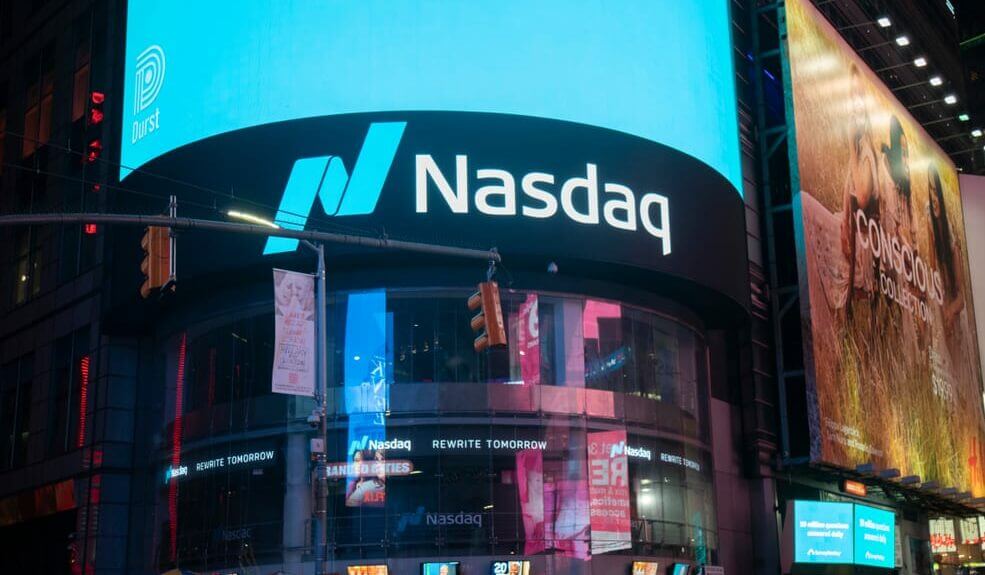
What is USTEC, and what is in it for traders?
As the world’s second most followed stock index, the Nasdaq e is an American stock exchange representing companies with high growth potential. This is a benchmark indicator of economic performance in the USA and around the world.
The Nasdaq is the second-largest American stock market in the United States by volume. The largest US market is the New York Stock Exchange (NYSE). It attracts many investors who are often interested in technology stocks, which are stocks offering good growth prospects over time.
The Nasdaq market is often confused by novice and amateur investors with the stock indices of the same name: the Nasdaq-100 stock index, the Nasdaq Financial-100 index, and the Nasdaq Composite stock index.
The Nasdaq-100 index, also called USTEC, comprises the 100 non-financial companies listed on the Nasdaq market (almost only technology stocks).
The Nasdaq Financial-100 index comprises the 100 financial companies listed on the Nasdaq market.
Finally, the Nasdaq Composite index is the most famous among investors, which includes all companies listed on the Nasdaq market.
What is USTEC?

The USTEC, or Nasdaq-100, is a stock market index of the 100 largest companies listed on the Nasdaq. Companies in the technology sector largely dominate the index. IT and internet companies represent more than half of the index. With 6% of the index, the health sector, particularly biotechs, has a significant weight in the index.
USTEC represents the US Tech 100 File, a financial exchange record that tracks the presentation of the best 100 innovation organizations recorded on the Nasdaq stock trade. The USTEC list incorporates organizations from various innovation-related businesses like programming, web, equipment, and media communications. Probably the most notable companies are Amazon, Google, Facebook, and Microsoft.
Investors frequently utilize the USTEC record as a benchmark for the presentation of the innovation area in the US securities exchange. The record is weighted given market capitalization, implying that bigger companies greatly affect the general performance of the index. The USTEC index is a significant mark of the well-being and development of the US innovation area and is firmly watched by traders, investors, and monetary experts.
Eligibility criteria for the USTEC index
The US Tech 100, or the Nasdaq 100, has explicit qualification standards for consideration in the record. Here are the essential factors for companies to be indexed on the list for the US Tech 100:
Being listed on the Nasdaq stock exchange: They should be recorded on the Nasdaq stock market, known for their emphasis on innovation and growth-oriented businesses.
Market cap: Companies should have a market cap of something like $10 billion.
Trading volumes: Companies should have a minimum trading volume of 100,000 shares each day, by and large.
Stability: Companies should have a strong market position and be productive.
Non-financial factors: Companies should meet specific criteria related to accounting standards, corporate administration, and other different variables.
The USTEC is rebalanced and reviewed consistently, on a quarterly premise, to guarantee that it lists the most qualified and significant businesses for the US tech sector.
The history of USTEC – Nasdaq 100

2016: At the end of 2016, 461 different companies were historically listed in the Nasdaq 100 index. But only four companies have been part of this index since its creation, namely Apple, Costco, Intel, and PACCAR.
2020: The Nasdaq 100 – USTEC, is one of the stock market indices that has best resisted the Covid pandemic. Its price will thus only fall from 9,623 to 6,994 points between February and March before rising again.
2021: In 2021, the composition of the NASDAQ 100 is 57% derived from technology stocks. We also find consumer services for 21.99%, which is the second most important sector of industry, public health for 7.08%, consumer goods companies for 6.14%, and industrial companies for 5.92%.
2022: In January 2022, the Nasdaq broke a new all-time high at over 16,200 points. It will then experience a technical correction and a further decline caused by the conflict in Ukraine until it reaches 13,070 points in April.
From the point of view of technical analysis, the Nasdaq 100, which recently rebounded on the bullish support constituted by the 100-day moving average (average updated each session of the last 100 closing prices), is sending an encouraging signal by extracting itself from the top of its bearish channel.
Largest companies in USTEC
According to Interbrand, the four largest companies listed on USTEC, and Nasdaq 100, are Microsoft, Amazon, Google, and Apple. Unsurprisingly, the constantly thriving business landscape, quick adaptation to change, employee buy-in, and a strong base of customers have helped these companies to thrive.
Technology companies have the greatest success, and it wasn’t just the major ones like Apple and Amazon that saw growth. Out of the 87 brands that returned from last year’s list, 67 increased their value by 5% or more. Additionally, 29 of the brands on the list saw an increase in brand value of over 50%.
How to trade the USTEC index?

Traders can invest in the Nasdaq 100 Index through various methods, including ETFs (Exchange-Traded Funds) like the Invesco QQQ ETF (QQQ). This kind of investment allows people to acquire or sell shares that follow the index’s performance.
The Nasdaq 100 Index can be traded through futures and options contracts. Futures contracts involve an agreement to purchase or sell the index at a predetermined rate and date and are traded on futures exchanges, with a margin deposit required.
Options contracts, which are similar to futures contracts, give investors a choice to buy or sell the index at a pre-set rate and date and are traded on options exchanges, requiring a margin deposit.
Contract for Difference (CFD): CFDs allow traders to speculate on the movement of the Nasdaq 100 Index without owning the underlying asset. Trading CFDs involves predicting the direction of the index and placing a trade accordingly, either long or short.
Some wise investments in USTEC
ETF AMUNDI NASDAQ-100 UCITS
Created in April 2019, the AMUNDI PEA NASDAQ 100 UCITS – EUR (C/D) (ISIN FR0013412269) ETF aims to replicate the performance of the Nasdaq 100 index without leverage.
Denominated in euros, it has just over 100 million euros in assets under management, with a method of synthetic replication of its underlying index. In addition, management fees amount to 0.23% per year, and the fund reinvests dividends (capitalization).
The three main stocks that make up the Nasdaq 100 index are Apple (12.84%), Microsoft (10.70%), and Amazon (5.21%).
LYXOR NASDAQ-100 UCITS
Launched in May 2014, the LYXOR NASDAQ 100 also offers to replicate the performance of the Nasdaq 100 index.
With nearly 110 million euros in assets under management, this ETF partially replicates its benchmark index.
Investors wishing to invest their money in this fund must pay an ongoing annual management fee of 0.30%. It is, therefore, a little more expensive than the Amundi ETF. Note that the company’s income that makes up the fund is capitalized (no distribution of dividends).
LYXOR NASDAQ

Launched in June 2006, the LYXOR NASDAQ 100 offers to replicate the performance of the Nasdaq 100 index daily with a multiplier effect of 2.
With nearly 260 million euros in assets under management, this ETF adopts a synthetic replication of its benchmark index.
Reserved for experienced traders who master the risks associated with the beta slippage effect, it allows you to increase your performance by betting on an upward trend in the Nasdaq 100 in the short term.
On the other hand, be aware that this is a capitalizing ETF and that the current management fees amount to 0.60% per year, which is a particularly high level compared to the other two ETFs in our selection.
INTEL (INTC)
Intel Corporation is an American multinational technology company located in Santa Clara, California. It is the world’s largest semiconductor chip maker by revenue and one of the developers of the x86 instruction sets in most personal computers.
Intel is a major player in the semiconductor industry with a track record of excellent financial performance. The company is well positioned for future growth as demand for semiconductors continues to increase.
The advantage is that Intel is a world leader in the semiconductor industry. The company has strong financials, with revenue growing 1.49% year-over-year from 2020. Intel has a track record of strong research and development spending, which has resulted in many innovative products.
NVIDIA (NVDA)
Nvidia is an American multinational technology company incorporated in Delaware and based in Santa Clara, California. It designs graphics processing units (GPUs) for the gaming and professional markets and systems-on-chips (SoCs) for mobile computing and the automotive market.
Nvidia is a top-tier technology company that has consistently posted solid financial performance. The company has a diverse product portfolio and is well-positioned for future growth. Nvidia products are popular with consumers and have a loyal customer base.
In Conclusion – Investing in USTEC
The USTEC has been largely invested in flourishing industries such as technology, which has contributed to its strong outperformance of the S&P 500 between 2007 and 2021. According to Interbrand and Kantar BrandZ, USTEC firms have maintained their place as some of the world’s most notable brands. It is not difficult for individual investors to access the USTEC names through the Invesco QQQ ETF, which tracks the index and other investment instruments.
USTEC index – FAQ

What is USTEC?
The USTEC, or Nasdaq-100, is a stock market index of the 100 largest companies listed on the Nasdaq. Companies in the technology sector largely dominate the index.The USTEC index is a significant mark of the well-being and development of the US innovation area and is firmly watched by traders, investors, and monetary experts.
Is NAS100 and USTEC the same?
The Nasdaq-100 Index (NDX), also known as the USTEC, is a stock market index representing the performance of 100 non-financial companies listed on the Nasdaq stock market.
What are Eligibility criteria for the USTEC?
Here are the essential factors for companies to be indexed on the list for the US Tech 100:being listed on the Nasdaq stock exchange, market capitalization, trading volumes, stability of the company and accounting standards.
What are the largest companies in USTEC?
According to Interbrand, the four largest companies listed on USTEC, and Nasdaq 100, are Microsoft, Amazon, Google, and Apple. Unsurprisingly, the constantly thriving business landscape, quick adaptation to change, employee buy-in
How to trade the USTEC index?
You can trade using ETFs, contracts for difference or options contracts. It is not difficult for individual investors to access the USTEC names through the Invesco QQQ ETF, which tracks the index and other investment instruments.




